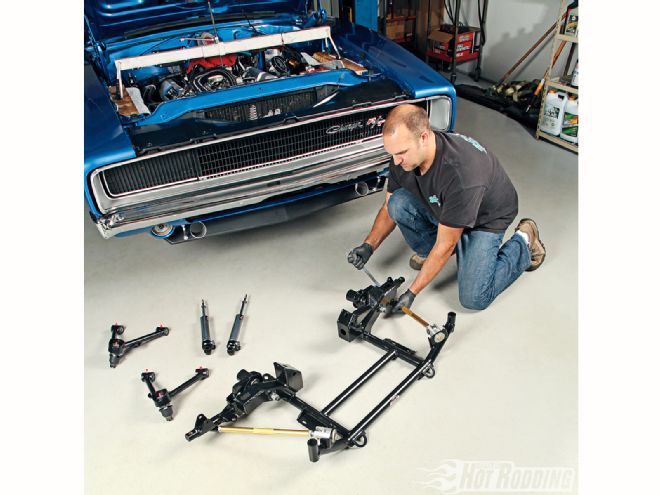
Any part bolted to an old car just about begs to be replaced. Of those bolt-ons, intermediate Chrysler products have the Holy Grail: a platform that serves as the mooring for the engine and most of the front suspension components. The aftermarket just couldn't wait any longer to make something to replace Ma Mopar's K-member.
In their defense, it had good reason. Though respectable for a part from a mass-produced car, that K-member takes up precious space for headers and high-capacity oil pans. Its rather flat shape and spot-welded construction leave strength on the table, too.
The tubular K-members developed by the aftermarket address those issues but often at a price. By itself, a tubular K-member isn't necessarily expensive; however, most manufacturers design them specifically to work as a package with other special components like control arms, coilover dampers, steering racks, and so on. And those parts add up.
"We looked at the components that people are making for the Mopar market," QA1's Dave Kass says. "What we found is a big void where people want to keep their torsion bars, but want to run a bolt-in K-member and maybe control arms." So the company embarked upon a two-year development program to create a pretty novel system for B- and E-Body Chrysler products (the company also makes counterparts for the A-Body cars but for the purposes of this install we'll concentrate on the intermediates).
Like its competition, QA1 designed its tubular K-member and a series of suspension components for those cars. Only unlike its competition, the company designed each component to interchange with its OEM counterpart. "We based everything off of factory geometry and pickup points," Kass says. "That lets someone start off with, say, a pair of upper or lower control arms or a K-member or our Dynamic Strut Bars. Then they can build as they go in whatever order they want. That's not an option with other kits on the market," he observes. "You have to buy everything at once otherwise the pieces won't work with the others. This way lets someone structure a kit in stepping stones if you will."
Just because the parts interchange with OEM components doesn't mean that QA1 made fancy-looking versions of stock parts though; each one indeed addresses shortcomings. Beyond space and strength, the K-member (PN 52315, MSRP $694.95) accommodates later and potentially stiffer E-Body sway bars. And because the system retains the torsion bars, it doesn't require elaborate accommodations for coilover dampers (another element that dramatically increases cost).
The tubular control arms offer far more structural integrity than the open-channel parts they replace. Urethane bushings in the upper arms (PN 52305, MSRP $349.95) reduce deflection. For reasons explained later, QA1 delivers the lower arms (PN 52308, MSRP $449.95) with rubber bushings; however, they can be retrofitted with urethane.
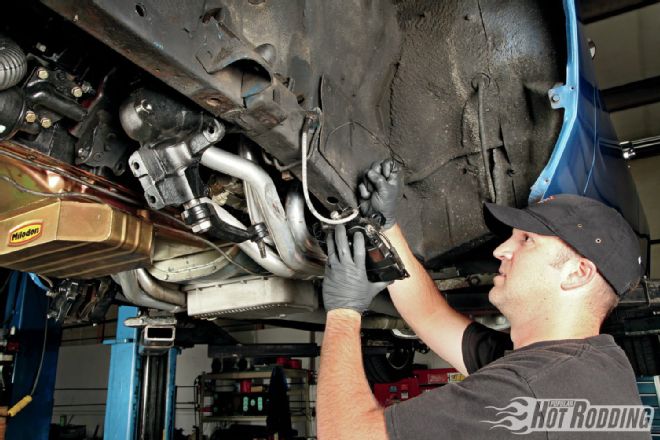 1. To test QA1’s claims that its K-member directly replaces the stock part, Marty Sokulski and Howard Daffern suspended the drivetrain with a bridge and tied up the steering box and brake components. They didn’t even need to crack a single brake line.
1. To test QA1’s claims that its K-member directly replaces the stock part, Marty Sokulski and Howard Daffern suspended the drivetrain with a bridge and tied up the steering box and brake components. They didn’t even need to crack a single brake line.
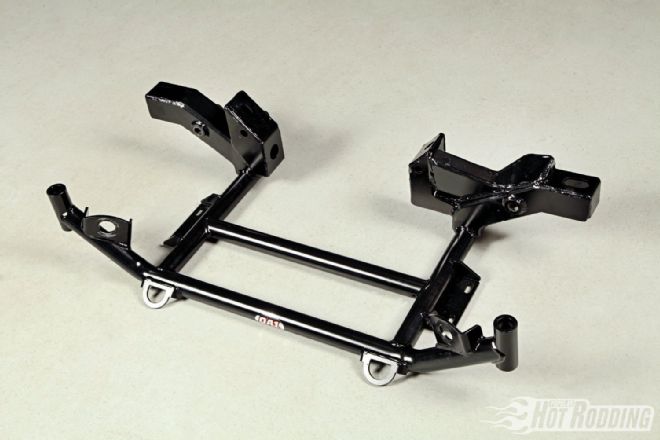 2. It looks lighter but QA1 found it impossible to make its K-member appreciably lighter without compromising its integrity. According to the company, the unit resists deflection to a far greater degree thereby lending the chassis much needed rigidity.
2. It looks lighter but QA1 found it impossible to make its K-member appreciably lighter without compromising its integrity. According to the company, the unit resists deflection to a far greater degree thereby lending the chassis much needed rigidity.
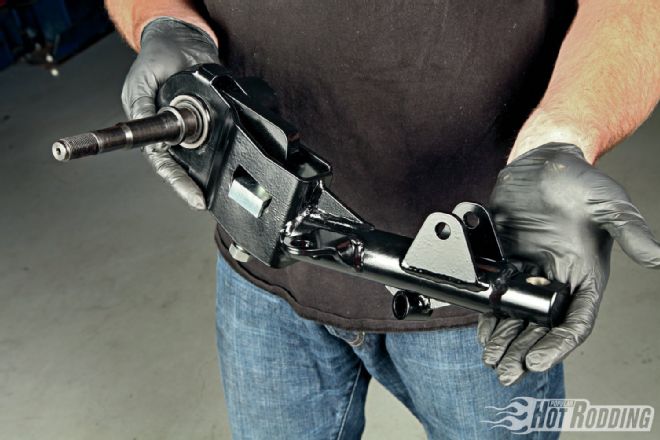 3. As noted earlier, the control arms replace the stock pieces directly. Their tubular construction offers far greater rigidity than the channel-shaped stock arms without increasing unsprung mass. These feature the company’s eccentrics and adjusters, and the strut rod, shock, and ball joint locations correspond to the stock positions.
3. As noted earlier, the control arms replace the stock pieces directly. Their tubular construction offers far greater rigidity than the channel-shaped stock arms without increasing unsprung mass. These feature the company’s eccentrics and adjusters, and the strut rod, shock, and ball joint locations correspond to the stock positions.
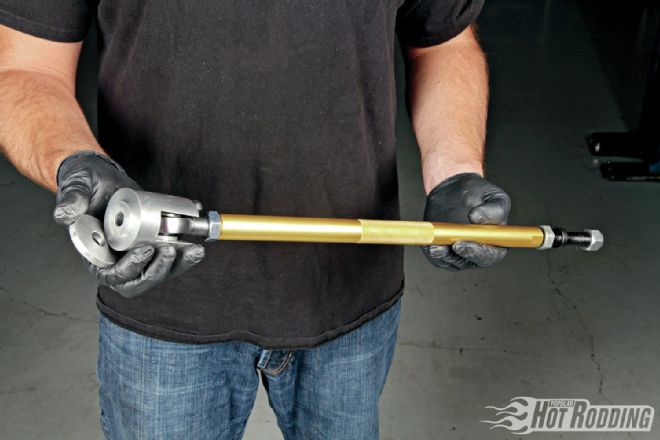 4. Aluminum construction makes QA1’s Dynamic Strut Bar far lighter than stock. The larger-diameter member better resists deflection, and adjustment points at both ends simplify in-car tuning.
4. Aluminum construction makes QA1’s Dynamic Strut Bar far lighter than stock. The larger-diameter member better resists deflection, and adjustment points at both ends simplify in-car tuning.
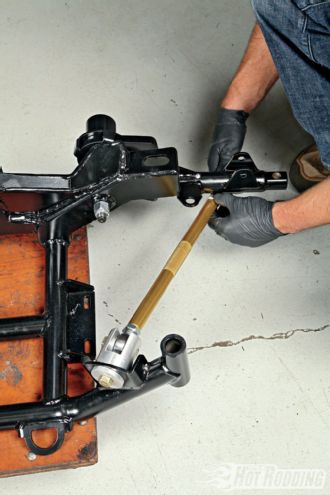 5. The Dynamic Strut Bar solves another issue. By aligning its rod end with the control arm centerline, QA1 made both components follow the same arc (because of its mount the stock strut rod actually pulls the arm forward as it cycles through its travel).
5. The Dynamic Strut Bar solves another issue. By aligning its rod end with the control arm centerline, QA1 made both components follow the same arc (because of its mount the stock strut rod actually pulls the arm forward as it cycles through its travel).
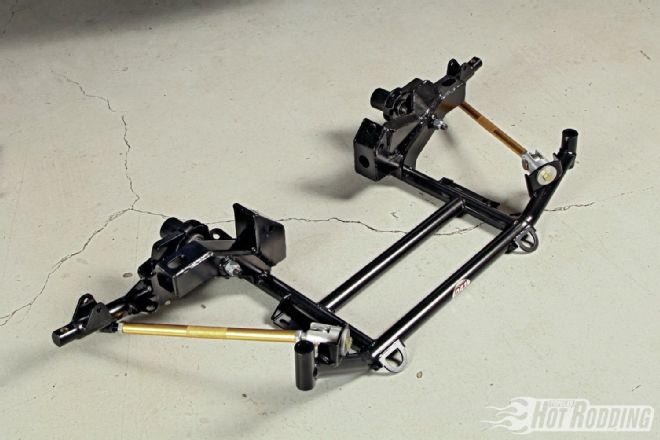 6. Note just how much less space the QA1 design consumes. Also note how much more elegant the company made the engine and steering box mounts.
6. Note just how much less space the QA1 design consumes. Also note how much more elegant the company made the engine and steering box mounts.
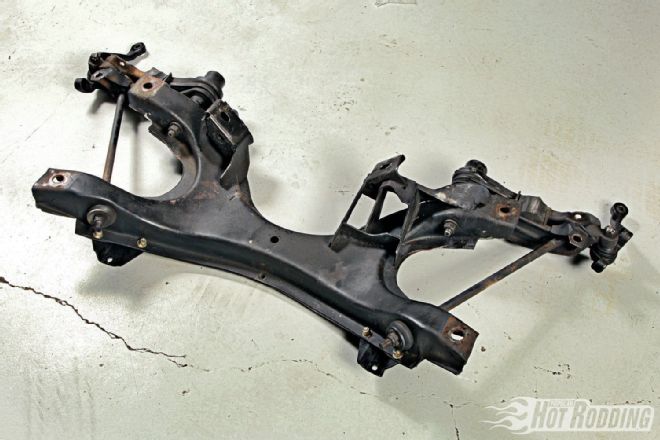 7. Here’s how the components look when assembled. Compare the shape with that of the OEM unit.
7. Here’s how the components look when assembled. Compare the shape with that of the OEM unit.
Last, but certainly far from least, is the replacement strut rods QA1 refers to as Dynamic Strut Bars (PN 52312, MSRP 219.95). The bars' greater cross-section also minimizes deflection under hard braking and lateral load. But probably the bar's most critical feature is its robust rod end. The OEM strut rod mounted in a pillow bushing strikes its own arc, which conflicts with the control arm's arc. The bind those arcs generate explain the premature bushing wear these cars suffer. But the bind never occurs because the rod end on the Dynamic Strut Bar pivots on the exact axis as the control arm.
That bind-free operation along with the more positive control arm location justifies QA1's decision to retain the lower control arm's more compliant rubber bushings. "When you get into components that have a higher durometer, more road imperfections can resonate through the body and get to the driver," Kass notes. "That's unwanted for a lot of people; they're not building a true race car."
Every bit as important as what these parts do is what they don't do. They do not modify the vehicle in any permanent way; the stock parts can be returned with nobody the wiser. Contrary to what their lighter visual appearance suggests, they don't reduce weight appreciably either. "About two months went into just finding ways to shave weight," Kass observes. Of course a weight-conscious and engineering-driven Chrysler gave QA1 quite a task. "We did (shed weight) in some places but we also found that if you take away a significant amount of weight some of that flex comes back. It doesn't make sense to pay for another piece just to get the same results as stock parts."
And beyond eliminating the lower control arm bind these parts don't alter the suspension geometry. It's an idea that puzzles some enthusiasts but QA1 says it has a good reason: The design doesn't need it. True, first-generation ponycars from the other manufacturers suffer positive camber curves and high roll centers. But just as GM did with its second-generation F-Body, Chrysler gave its 1971-and-later B-Body and 1970-and-later E-Body cars a pretty respectable negative camber curves and low roll centers. That's a happy coincidence; worthwhile suspension improvements usually require at least relocating the upper control arm mounting points, a tricky proposition in a car that locates those parts in integrated body components.
"But that doesn't mean [an enthusiast] can't improve handling," Kass maintains. "With these pieces a car is going to feel a lot more composed. [The] average street driver who goes to and from shows and does the occasional track time doesn't want a race car anyway."
Publishing constraints prevent us from getting real-world feedback (this K-member is one of the first two production pieces), but we expect to hear about it. This assembly went to Marty Sokulski, an avid autocross enthusiast who cut his teeth in the NASCAR AutoZone Elite Division (in fact, his team partner Howard Daffern works at Cascade Auto Clinic, the Redmond, Washington, shop that graciously donated shop time to the cause). He's one of a handful of people QA1 consulted during these products developments, and his structurally pristine '68 Charger served as one of the company's guinea pigs.
We may not have real-world feedback at this time, but we have the confidence that QA1 did its homework. After all, QA1 has a lot riding on these crossmember and suspension assemblies, and it knows how critical the enthusiast market is. Most importantly, QA1 also knows that the bolts that make it so easy to install this piece will come right back out if it doesn't perform to standards. But, according to the amount of thread-locker Sokulski used during the installation, we think he feels equally confident about the design.
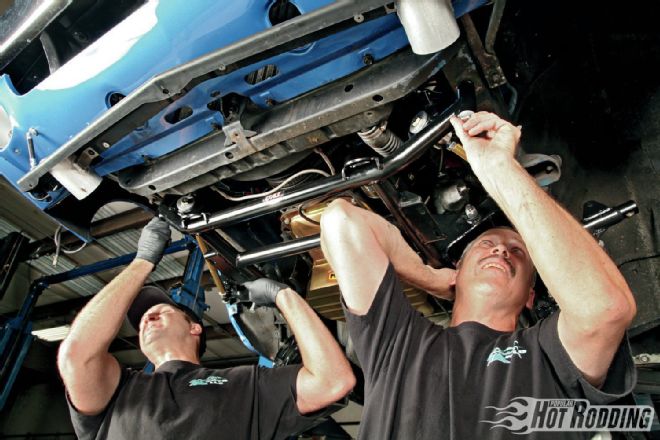 8. Rather than build the assembly on the car, Sokulski and Daffern built it on the ground and installed it as a unit. It went in with little fanfare, a surprise since the assembly had to align with the dangling engine. If working on the ground a floor jack would do the trick in a snap.
8. Rather than build the assembly on the car, Sokulski and Daffern built it on the ground and installed it as a unit. It went in with little fanfare, a surprise since the assembly had to align with the dangling engine. If working on the ground a floor jack would do the trick in a snap.
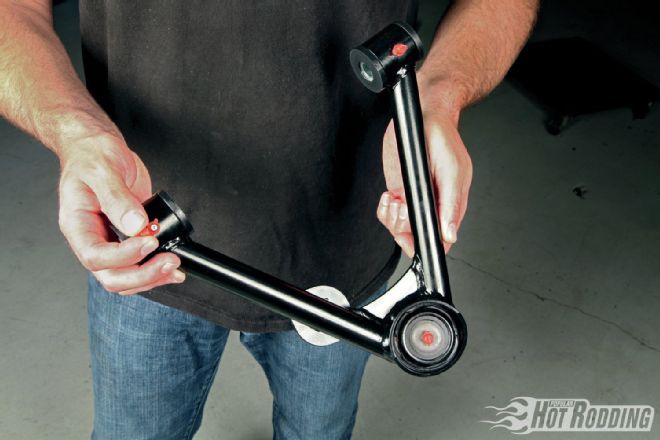 9. QA1’s upper arms replaced other aftermarket arms so we don’t have a good OEM comparison. If lubricated with high-tack silicone grease as urethane manufacturers recommend, the bushings won’t squeak for years, if ever; however, QA1 equips these with grease fittings just in case.
9. QA1’s upper arms replaced other aftermarket arms so we don’t have a good OEM comparison. If lubricated with high-tack silicone grease as urethane manufacturers recommend, the bushings won’t squeak for years, if ever; however, QA1 equips these with grease fittings just in case.
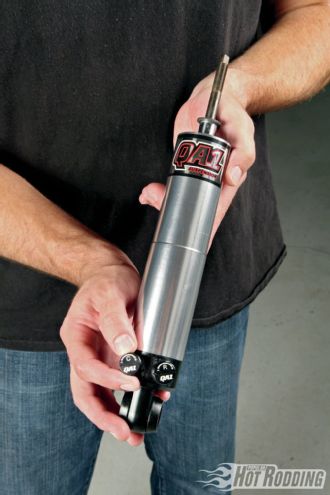 10. The company also supplied this kit with its bearing-style double-adjustable damper (PN DD301, MSRP $284.95 each). It’s a non-pressurized twin-tube design but QA1’s Dave Kass maintains that it shouldn’t suffer cavitation even under aggressive circumstances.
10. The company also supplied this kit with its bearing-style double-adjustable damper (PN DD301, MSRP $284.95 each). It’s a non-pressurized twin-tube design but QA1’s Dave Kass maintains that it shouldn’t suffer cavitation even under aggressive circumstances.
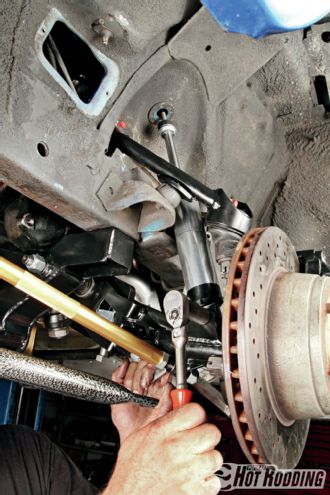 11. Pads welded to the arms align perfectly with the chassis’ rebound snubbers. QA1 supplied shorter dampers to suit this Charger’s lowered stance, a variation that extended the dampers before the snubbers hit. Though QA1 doesn’t supply one with the kit, OEM and late E-Body sway bars fit the design.
11. Pads welded to the arms align perfectly with the chassis’ rebound snubbers. QA1 supplied shorter dampers to suit this Charger’s lowered stance, a variation that extended the dampers before the snubbers hit. Though QA1 doesn’t supply one with the kit, OEM and late E-Body sway bars fit the design.
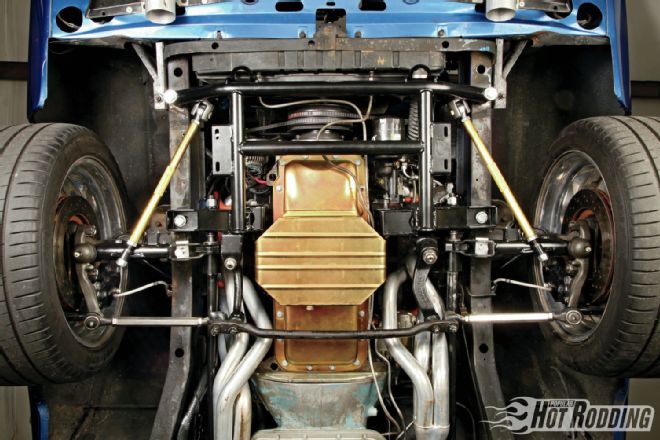 12. As this worm’s-eye view shows, the QA1 components open acres of precious room around the headers and steering box. To our great surprise it didn’t interfere with the wide-sump Milodon pan either. The greater space offers ordinary handtools plenty of access to previously buried fasteners.
12. As this worm’s-eye view shows, the QA1 components open acres of precious room around the headers and steering box. To our great surprise it didn’t interfere with the wide-sump Milodon pan either. The greater space offers ordinary handtools plenty of access to previously buried fasteners.